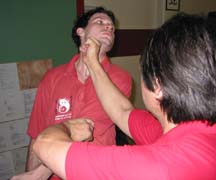The Australian School of Kung Fu
and Tai Chi











|
Chow Gar Style
Chow Gar Tong Long (Southern Praying Mantis) kung fu was designed
with two main principles in mind - practicality and effectiveness.
The Chow Gar style eliminates any techniques which would not be effective
in realistic conflicts. Any moves which are flashy or just "look
good" have been removed. Techniques that are complex and
difficult to execute have no place in Chow Gar.
Chow Gar was developed for use on the battlefields of imperial
China. Its goal was to cause maximum damage while expending as
little time and effort as possible. Chow Gar has proven that it
is equally suited for the confrontations of today's world as well.
The main characteristics of the Chow Gar Tong Long style are as follows:
- Aggressiveness. The principle behind Chow Gar is that
the best offense is also the best defense. There are few techniques
dedicated to blocking. Most techniques focus on attack. Any blocks
that are involved are designed to redirect an opponent's
force against them. The source of the problem should be dealt
with, not the symptom.
- Speed. All techniques are designed for maximum speed.
This is achieved by starting the technique from a relaxed state
before finishing it with a quick contraction of the tendons.
Fast footwork is also essential in Chow Gar to close distances
as quickly as possible. The opponent is usually not allowed to
throw more than one punch or kick before bearing the full assault.
- Fluidity. Most techniques are designed so that they
can be seamlessly strung together in a fast, rapid assault. The
practitioner will not stop the attack until the opponent is down.
- Power. Every single move in Chow Gar is designed for
maximum power output. This is achieved by using external power
(ging), which is triggered by the movement of the legs,
waist, elbows, wrists, and fingers. Internal power (chi)
is also harnessed through breathing techniques. At advanced levels,
"shock power" is developed, giving the practitioner
the ability to inflict great damage at a very short distance,
e.g. the one-inch punch that Bruce Lee made famous.
- Sensitivity. Chow Gar places strong emphasis on the
"sticky hands" principle; that is, keeping constant
contact with the opponent so that you always know where they
are and what they are trying to do. In this way, it allows you
to control your adversary and to detect openings in their defense.
Using the sense of touch also allows for a quicker and more suitable
response rather then relying on sight alone.
- Accuracy. Chow Gar favours striking at an opponent's "pressure
points". These are points within the body typically located near major
arteries or nerves. Attacking these areas can be debilitating to an opponent,
often causing that part of the body to be numbed or paralysed for a short period of
time. Striking certain pressure points may also cause death as they can
temporarily halt blood flow in an artery. Such strikes are known as dim mak, or "death touch" techniques, and
are only taught at advanced levels.
- The Bridge. A fundamental principle of Chow Gar is
the concept of the "bridge". At least one of the practitioner's
arms will usually be in the bridge position during most techniques.
The bridge provides solidity in strikes and in the basic guard.
A bridge is achieved by keeping the elbow pointed downwards and
inwards, just like the mantis insect. Any force which pushes
against the bridge will be countered by the complete body strength
of the practitioner, instead of just the arm.
- Close Range. Chow Gar's preferred distance of attack
is as close as possible to the opponent. This is done in order
to crowd the opponent's space, upset their balance, and to minimise
the time it takes for a technique to strike the target. It is
also more difficult for an opponent to strike vital points with
accuracy at such close range. Chow Gar also employs medium-range
techniques, but relies more on quick footwork to close the distance.
- Low Kicks. In keeping with the principles of practicality,
effectiveness, and speed, there are no high kicks in Chow Gar.
All kicks are aimed low and are designed to strike the opponent's
legs and lower body.
- Weapons. Given that the style was used extensively
on the battlefield, weapons are an important part of Chow Gar.
Weapons training serves to increase one's strength, footwork,
and coordination. Weapons utilised in the style are the spear,
butterfly knives, walking stick, sai (short tridents), broadsword,
and guan dao (broadsword-bladed spear with a spike on the other
end).
- Yin Yang Philosophy. Chow Gar adheres strongly to
the Chinese philosophy of Yin Yang. One often gives in order
to gain. An opponent's force is often diverted and used against
them. There is equal emphasis placed on internal and external
aspects of kung fu. Physical power is necessary, but correct
breathing and utilisation of one's chi is equally as important.

 | | |
| | |
| | |
| | |
| | |
| | |
|











